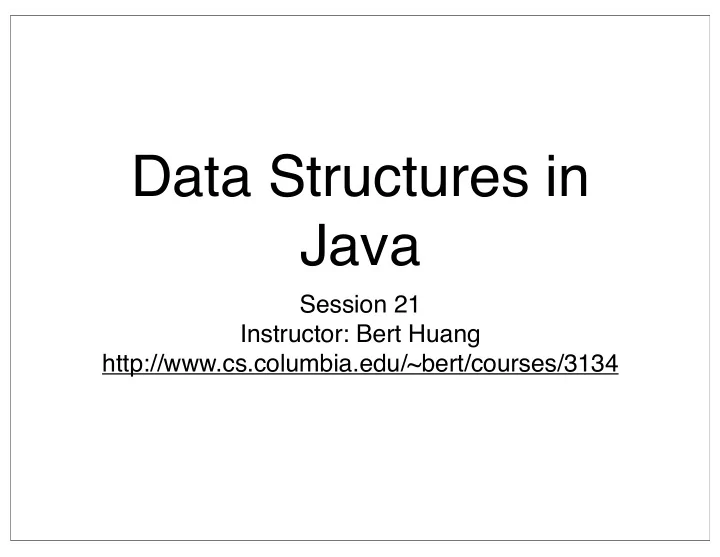

Data Structures in Java Session 21 Instructor: Bert Huang http://www.cs.columbia.edu/~bert/courses/3134
Announcements • Homework 5 due • Midterm solutions posted (sorry!) • Homework 6 to be posted this weekend
Review • Radix Sort specifics • Comparison sorting algorithm characteristics • Algorithms: Selection Sort, Insertion Sort, Shellsort, Heapsort, Mergesort, Quicksort
Today ʼ s Plan • Sorting Algorithm Examples • QuickSort space clarification • External Sorting
Summary Worst Average Space Stable? Case Time Time Selection No O ( N 2 ) O ( N 2 ) O (1) Insertion O ( N 2 ) Yes O ( N 2 ) O (1) Shell O ( N 3 / 2 ) No O (1) ? Heap No O ( N log N ) O ( N log N ) O (1) Merge Yes/No O ( N log N ) O ( N log N ) O ( N ) /O (1) Quick No O ( N 2 ) O ( N log N ) O (log N )
Selection Sort 3 7 5 2 6 1 0 4 0 7 5 2 6 1 3 4 0 1 5 2 6 7 3 4 0 1 2 5 6 7 3 4 0 1 2 3 6 7 5 4 0 1 2 3 4 7 5 6 0 1 2 3 4 5 7 6 0 1 2 3 4 5 6 7
Insertion Sort 3 7 5 2 6 1 0 4 3 7 5 2 6 1 0 4 3 5 7 2 6 1 0 4 2 3 5 7 6 1 0 4 2 3 5 6 7 1 0 4 1 2 3 5 6 7 0 4 0 1 2 3 5 6 7 4 0 1 2 3 4 5 6 7
Shell Sort I 3 7 5 2 6 1 0 4 3 7 5 2 6 1 0 4 2 7 5 3 6 1 0 4 0 7 5 2 6 1 3 4 0 6 5 2 7 1 3 4 0 4 5 2 6 1 3 7 0 4 1 2 6 5 3 7
Shell Sort II 0 4 1 2 6 5 3 7 0 1 4 2 6 5 3 7 0 1 2 4 6 5 3 7 0 1 2 4 5 6 3 7 0 1 2 3 4 5 6 7
Merge Sort 3 7 5 2 6 1 0 4 3 7 5 2 6 1 0 4 3 7 5 2 6 1 0 4 2 5 1 6 2 3 5 7 0 1 4 6 0 1 2 3 4 5 6 7
Quick Sort 3 7 5 2 6 1 0 4 3 7 5 2 6 1 0 4 3 0 5 2 6 1 7 4 3 0 5 2 6 1 7 4 3 0 1 2 6 5 7 4 2 0 1 3 6 5 7 4 0 1 2 3 6 5 7 4 0 1 2 3 6 5 7 4 0 1 2 3 6 5 4 7 0 1 2 3 4 5 6 7
QuickSort Space • QuickSort is a recursive algorithm • Each recursive call sorts a segment of the array, it must store the beginning and end of the segment • When the deepest recursive call is made, between N-1 and log N nested calls have occurred
External Sorting • So far, we have looked at sorting algorithms when the data is all available in RAM • Often, the data we want to sort is so large, we can only fit a subset in RAM at any time • We could run standard sorting algorithms, but then we would be swapping elements to and from disk • Instead, we want to minimize disk I/O, even if it means more CPU work
MergeSort • We can speed up external sorting if we have two or more disks (with free space) via Mergesort • One nice feature of Mergesort is the merging step can be done online with streaming data • Read as much data as you can, sort, write to disk, repeat for all data, write output to alternating disks • merge outputs using 4 disks
4-way MergeSort Merge Disk 3 Memory Disk 2 Sort & Copy Disk 1 Disk 0
Simplified Running Time Analysis • Suppose random disk i/o cost 10,000 ns • Sequential disk i/o cost 100 ns • RAM swaps/comparisons cost 10 ns • Naive sorting: 10000 N log N • Assume M elements fit in RAM. External mergesort: 10 N log M + 100 N (# of sweeps through data)
Counting Merges • After initial sorting, N/M sorted subsets distributed between 2 disks • After each run, each pair is merged into a sorted subset twice as large. • Full data set is sorted after log(N/M) runs • External sorting: 10 N log M + 100 N log (N/M) • (compare to 10000 N log N)
Reading • http://www.sorting-algorithms.com/ • Weiss Chapter 7 • Skim 7.4.1 (proof of Shell Sort) • Enjoy break!
Recommend
More recommend